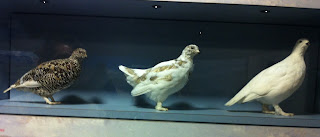In the last post, I took you to the top of the mountain, to the Tundra and explained exactly what that ecosystem involves. Like all ecosystems, plants and animals have to work together for survival in this environment. I explained a little about the plants in the Tundra but today I want to share what I learned about the animals., Surprisingly there are no bears up this high in the mountains! Reason?
Not much food there! They stay down in the treeline,-the forests where there are more plants and animals since they are omnivores. There are a few animals adapted for this high elevation though.
(top)This is the hardy ptarmigan and is adapted to withstand the cold winters. It is covered with insulating layers of feathers. They molt twice a year, changing their color to blend with the changing color of their habitat as seasons change. They conserve energy by moving slowly and seldom flying,
(Above)This is the long tailed weasel of the tundra.As you can see it molts twice a year and also changes its color to camouflage with the seasons. In the winter its heavy white coat provides warmth as well as providing camouflage as it hunts for food,
Not all animals choose to stay in the Tundra for the winter though, Some will choose to migrate down the mountain to warmer forests. The Elk is one such animal. We saw these animals everywhere at lower elevations.(Below left)
 (Below)Some animals do choose to stay and hibernate. This is a marmot and he stays put and is not active. for the long winters. Marmots sleep snug in their burrows for seven to eight months, their body temperature dropping to below 40 degrees to conserve energy.
(Below)Some animals do choose to stay and hibernate. This is a marmot and he stays put and is not active. for the long winters. Marmots sleep snug in their burrows for seven to eight months, their body temperature dropping to below 40 degrees to conserve energy. 
Like all ecosystems, plants and animals have to have adaptations to survive in their habitat.Think about the animals in your habitat, what do they have to help them survive? What adaptations do you have?


No comments:
Post a Comment